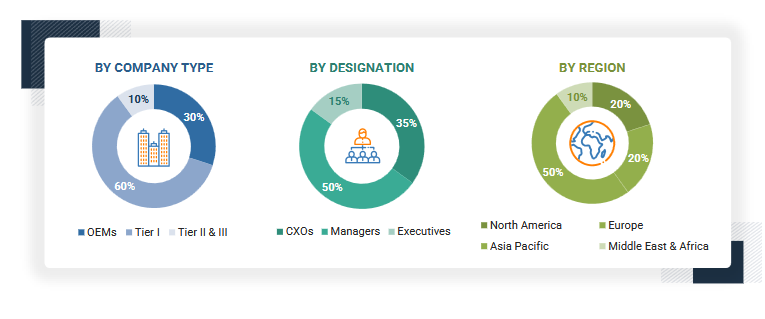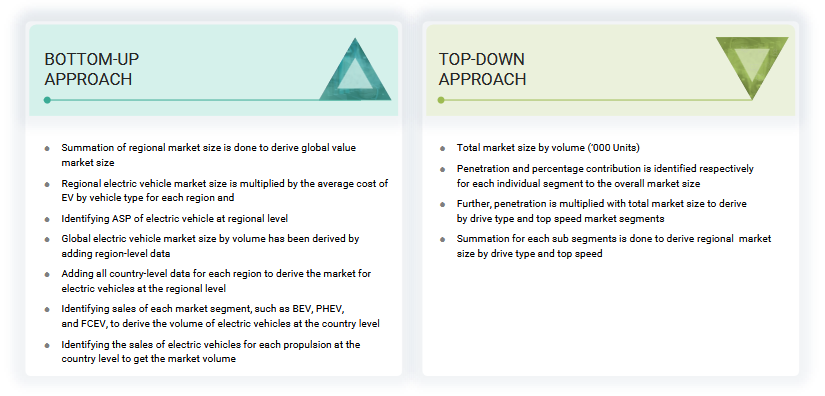This research study involved the extensive use of secondary sources, such as company annual reports/presentations, industry association publications, automotive magazine articles, directories, technical handbooks, the World Economic Outlook, trade websites, technical articles, and databases, to identify and collect information on the Electric Vehicle market. In-depth interviews were conducted with various primary respondents, including key industry participants, subject-matter experts (SMEs), C-level executives of key market players (electric vehicle manufacturers and suppliers), and industry consultants, among other experts, to obtain and verify critical qualitative and quantitative information and assess market prospects.
Secondary Research
In the secondary research process, various secondary sources were used to identify and collect information on the electric vehicle market for this study. Secondary sources include annual reports, press releases, and investor presentations of companies; whitepapers, certified publications, and articles from recognized authors; directories; databases; and articles from recognized associations and government publishing sources.
Primary Research
Extensive primary research was conducted after understanding the electric vehicle market scenario through secondary research. Several primary interviews were conducted with market experts from both demand-side vehicle manufacturers [(in terms of component supply) country-level government associations and trade associations] and supply-side OEMs and component manufacturers across three major regions, namely, North America, Europe, and Asia Pacific. Approximately 30% and 70% of primary interviews were conducted from the demand and supply sides, respectively. Primary data was collected through questionnaires, emails, and telephonic interviews. In the canvassing of primaries, various departments within organizations, such as sales, operations, and administration, were covered to provide a holistic viewpoint in the report.
In the canvassing of primaries, various departments within organizations, such as sales, operations, and marketing, were covered to provide a holistic viewpoint in the report. After interacting with industry experts, brief sessions were conducted with highly experienced independent consultants to reinforce the findings from primaries. This, along with the opinions of in-house subject matter experts, led to the findings, as described in the remainder of this report.

To know about the assumptions considered for the study, download the pdf brochure
Market Size Estimation
A detailed market estimation approach has been followed to estimate and validate the value of the global electric vehicle market and other dependent submarkets, as mentioned below:
-
The market size has been derived by using parameters such as sales of electric vehicles.
-
Segment split has been identified through primary and secondary research.
-
Key players in the global electric vehicle market have been identified through secondary research, and their global market share was determined through primary and secondary research.
-
The research methodology includes the study of the annual and quarterly financial reports & regulatory filings of major market players as well as interviews with industry experts for detailed market insights.
-
All major penetration rates, percentage shares, splits, and breakdowns for the global electric vehicle market have been determined by using secondary sources and verified through primary sources.
-
All key macro indicators affecting the revenue growth of the market segments and subsegments have been accounted for, viewed in extensive detail, verified through primary research, and analyzed to get the validated and verified quantitative & qualitative data.
-
The gathered market data has been consolidated and added with detailed inputs, analyzed, and presented in this report.
The gathered market data was consolidated and added with detailed inputs, analyzed, and presented in this report.

To know about the assumptions considered for the study, Request for Free Sample Report
Data Triangulation
All percentage shares, splits, and breakdowns were determined using secondary sources and verified by primary sources. All parameters that affect the markets covered in this research study were accounted for, viewed in extensive detail, and analyzed to obtain the final quantitative and qualitative data. This data was consolidated, enhanced with detailed inputs and analysis from MarketsandMarkets, and presented in the report. The following figure is an illustrative representation of the overall market size estimation process employed for this study.
Market Definition
An electric vehicle (EV) is an automobile propelled by one or more electric motors. An EV uses energy stored in rechargeable batteries, which can be charged using private or public charging infrastructure. There are four major types of EVs, namely, battery electric vehicles (BEVs), plug-in hybrid electric vehicles (PHEVs), hybrid electric vehicles (HEVs), and fuel cell electric vehicles (FCEVs)
List of Key Stakeholders
-
Associations, Forums, and Alliances Related to EVs
-
Automobile Manufacturers
-
Battery Distributors
-
Battery Manufacturers
-
Charging Infrastructure Providers
-
Charging Services Providers
-
EV Charging Station Service Providers
-
EV Component Manufacturers
-
EV Distributors and Retailers
-
EV Manufacturers
-
Government Agencies and Policymakers
Report Objectives
-
To segment and forecast the electric vehicle (EV) market in terms of volume (Thousand Units) and value (USD Million)
-
To segment and forecast the market based on charging point type (AC (normal charging) and DC (super charging))
-
To segment and forecast the market based on Propulsion [(Plug-in Hybrid Electric Vehicle (PHEV), Fuel Cell Electric Vehicle (FCEV), and Battery Electric Vehicle (BEV)]
-
To segment and forecast the market based on vehicle type (passenger car and commercial vehicle)
-
To segment and forecast the market based on vehicle class (low-priced, mid-priced, and luxury)
-
To segment and forecast the market based on vehicle top speed (<125 mph and
>125 mph)
-
To segment and forecast the market based on vehicle drive type (front-wheel drive (FWD), rear-wheel drive (RWD), and all-wheel drive (AWD)
-
To segment and provide qualitative insights into the market based on vehicle connectivity (V2B or V2I, V2G, and V2V)
-
To segment and forecast the market based on E/E Architecture (400V and 800V)
-
To segment and forecast the market based on end use (private and commercial fleets)
-
To provide qualitative insights on EV Components
-
To segment the market and forecast its size, by volume, based on region (Asia Pacific, Europe, North America, and the Middle East & Africa)
-
To analyze the technological developments impacting the market
-
To analyze opportunities for stakeholders and the competitive landscape for market leaders
-
To provide detailed information regarding the major factors influencing market growth (drivers, challenges, restraints, and opportunities)
-
To strategically analyze markets with respect to individual growth trends, future prospects, and contribution to the total market
-
To strategically profile key players and comprehensively analyze their market shares and core competencies
-
To track and analyze competitive developments such as product developments, deals, and other activities carried out by key industry participants
AVAILABLE CUSTOMIZATIONS
With the given market data, MarketsandMarkets offers customizations in accordance with the company’s specific needs.
-
Electric vehicle market, by vehicle drive type at country-level (for countries covered in the report)
-
Profiling of additional market players (up to 5)



Mathew
May, 2022
We want to know the competitive scenario for Electric Vehicle Market? and the Top vendors in the EV Market for the Forecast period 2022 to 2030. .
Jhon
Dec, 2022
For the Asia market, we have provided the latest industry trends from both supply-side and demand-side, market insights for ASIA at the total and country-level (China, India, Japan and South Korea), and quantified the market size in units and revenues and growth forecast to 2030..
Wills
Dec, 2022
Electric Vehicle Market report also includes the latest industry trends from both supply-side and demand-side, market insights for ASIA market at the total and country-level (China, India, Japan and South Korea) data as well, and quantified the market size in units and revenues and growth forecast to 2030..